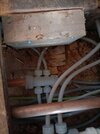- Joined
- 18 Oct 2020
- Messages
- 11
- Reaction score
- 0
- Country

This is a picture of the out flow? (Sorry if that's wrong terminology) from the boiler with 5 pipes split off going individually to each radiator (3 upstairs, 2 downstairs)
Then another return flow with another 5 pipes coming into it, with both connecting to a larger (22mm?) Pipe which comes from the boiler.
It seems like an awful lot of pipe for water to flow through. And diagrams I've seen, seem to show just 1 pipe, with 1 split off from each radiator, this reducing the flow and return.
I seem to be losing pressure from my boiler, and was looking for a potential leak. So is it possible to reduce the amount of pipework at the same time as trying to determining the source of the problem (could be something else, boiler is pretty old)

Then another return flow with another 5 pipes coming into it, with both connecting to a larger (22mm?) Pipe which comes from the boiler.
It seems like an awful lot of pipe for water to flow through. And diagrams I've seen, seem to show just 1 pipe, with 1 split off from each radiator, this reducing the flow and return.
I seem to be losing pressure from my boiler, and was looking for a potential leak. So is it possible to reduce the amount of pipework at the same time as trying to determining the source of the problem (could be something else, boiler is pretty old)

